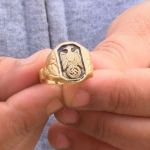Can You Watch This Ancient Optical Illusion?
The illusion itself isn’t new. It was first referenced in ancient Greek texts, although the origin is debated.
Many scientists agree Aristotle first mentioned the visual illusion in his Parva Naturalia, but the correct direction was said to be first reported by Lucretius in his poem De Rerum Natura.
The first clear description of the motion after-effect was recorded by Jan Evangelista Purkyně in 1820, who observed it after looking at a cavalry parade.
Robert Addams then observed and reported the effect in 1834 while watching a waterfall at Foyers in Scotland. This demonstration was created from a view of the Falls of Foyers.
Mr Addams noticed that the effect can be seen when staring at a waterfall while keeping eyes steady.
The longer the spinning, the more fatigued the clockwise cells get, and the more the opposite cells will be active to try and correct the imbalance of energy.
In the case of this video, uploaded by Science Forum, focusing on the letters causes the cells to stay tuned on the motion.
The variety of motions throughout the clip causes the cells to tire at different speeds, and the length of the clip combines to create an illusion that causes objects to move in a variety of directions.
HOW THE MOTION AFTER-EFFECT ILLUSION WORKS
The motion after-effect (MAE) can be explained by changes in visual neurons that respond in certain ways to moving parts within an image.
In the brain, there are cells are tuned to respond to different features and directions of an image or stimulus.
For example, there are cells in the brain that are sensitive to motion in a clockwise direction, but there are also cells that are sensitive to motion in the opposite direction.
When there is no movement within an image, these cells produce roughly the same response.
But, in the case of a simple MAE illusion, as the circles spin in a clockwise motion, the cells that are sensitive to this direction use energy and become tired.
When the spinning stops, the cells sensitive to motion in an anti-clockwise direction take over and become active - in a bid to restore the balance.
This causes even stationary items to look like they’re moving in that opposite direction for a short time.
Versions of the spiral were then used in 1849 by the Belgian physicist Joseph Plateau.
During the video the outer rings spin anti-clockwise.
A five-point shape features rings that move clockwise, while letters appear in the centre.
There is also another spinning circle around the letters.
The motion after-effect (MAE) can be explained by changes in visual neurons that respond in certain ways to moving parts within an image.
In the brain, there are cells are tuned to respond to different features and directions of an image or stimulus.
For example, there are cells in the brain that are sensitive to motion in a clockwise direction, but there are also cells that are sensitive to motion in the opposite direction.
When there is no movement within an image, these cells produce roughly the same response.
But, in the case of a simple MAE illusion, as the circles spin in a clockwise motion, the cells that are sensitive to this direction use energy and become tired.
When the spinning stops, the cells sensitive to motion in an anti-clockwise direction take over and become active - in a bid to restore the balance.
This causes even stationary items to look like they’re moving in that opposite, anti-clockwise direction for a short time.
.






